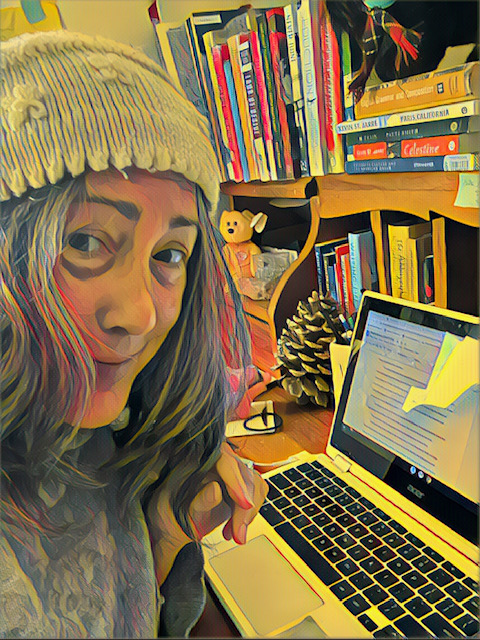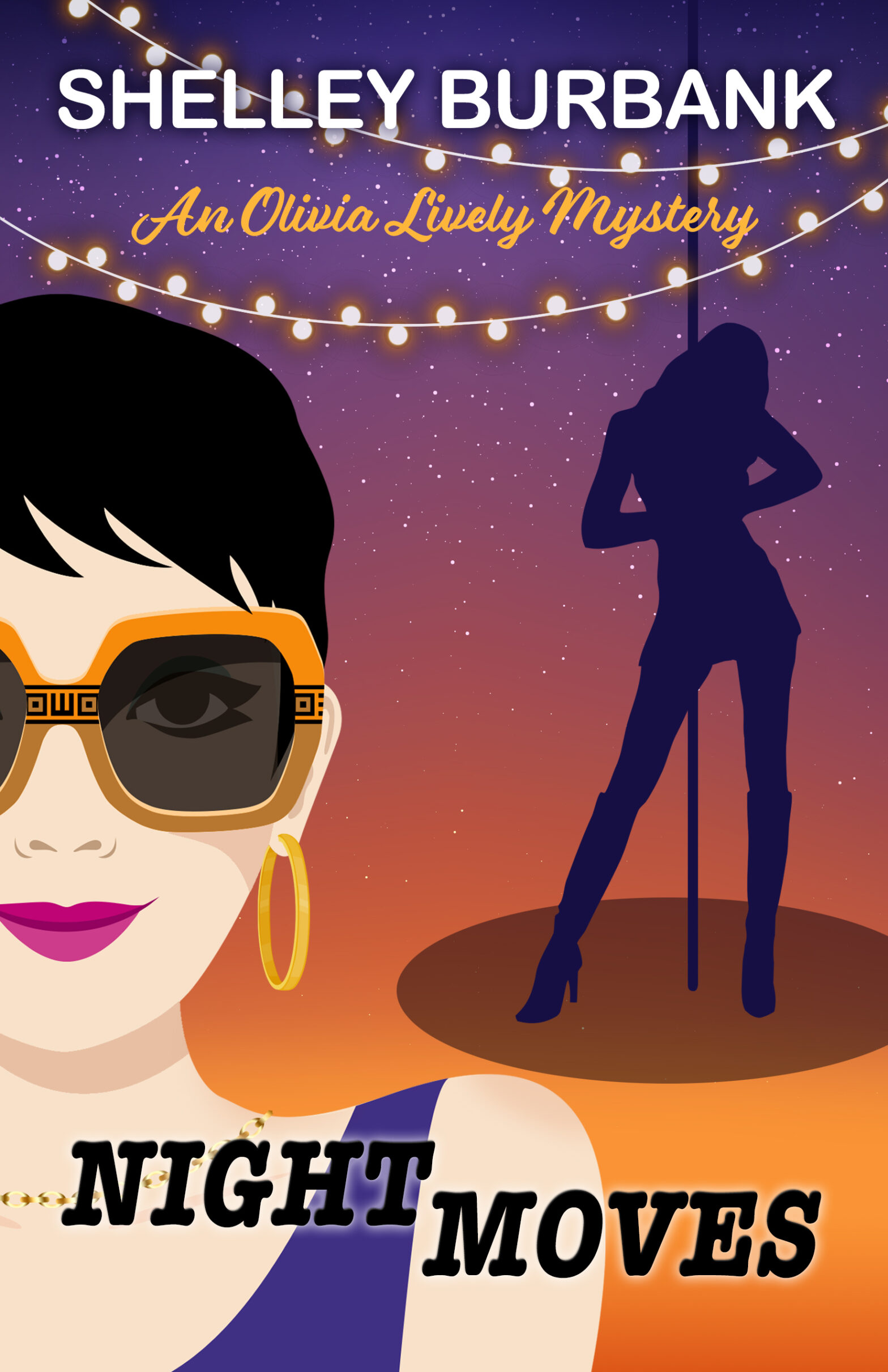On Monday my second Olivia Lively, PI mystery book, NIGHT MOVES, went up for sale on some of the major retail sites. The title is ready for pre-order. Hooray!
Book designer Deirdre Wait created yet another stand-out cover, and I think the purple and orange color and Liv’s big, yellow sunglasses will temp readers to take a closer look at the back cover description and then, hopefully, press that buy button.
Second Book Fears
To be honest, I’m feeling a bit overwhelmed at the moment.
Now that I’ve learned a few things after launching book one, I’ve been thinking about the months of promotion and marketing ahead for book two and wondering if I’ll make back the monetary investment I’ve already sunk into this one. I chose to hire a developmental editor to make sure my pacing and characterization worked, and if you think this comes cheap, you’d be wrong.
Besides money, I’ve spent months of my life writing, rewriting, and rewriting again. Looking ahead, I’ll spend more hours creating social media posts, sending out ARCs, and contacting libraries and other venues for potential author talks and podcast interviews. I still need to send my new and improved newsletter to subscribers. (See end of post.)
So the questions swirl in my mind. What if my second book doesn’t sell as well as my first? What if this is the last book I ever publish? What if nobody likes it? What if I’ve wasted years of my life endeavoring to be a good writer? Will it all have been for nothing?
These worries keep me awake at night.
Publishing Sales Figures Are Complex
I put hours and money into promotion and marketing in hopes of selling a good amount of books. So what’s a “good amount” you ask?
Nobody really knows.
There have been splashy articles about how most books sell 12 copies on average. This is most likely wildly inaccurate. Publishing is a complex industry, and sales by indie (self-pubbed) authors might not be tracked the same way as sales by a Big 5 press or a small press like the one who publishes my Liv Lively books.
Blockbuster best-sellers from the Big 5 and the occasional indie giant have blow-your-mind sales figures, of course.
Between the “sell a few copies” and the “blockbusters” at the far ends of the spectrum, sales like mine fall in the vast middle. With small or micro press books, sales are less like a blast to your brain and more like a mild zephyr gently stirring a strand of hair. Not hundreds of thousands of copies, true, but more than 12 at any rate. More than a total dead zone.
There are all kinds of reasons why small press books don’t usually reach those bestseller numbers. Bookstore placement and visibility in general are as difficult for small presses as they are for indie authors. Printing and distribution are handled differently. If you or your small press aren’t buying Facebook and Amazon ads like the successful indie authors do, you might as well resign yourself to relative obscurity.
Of course we indies and small press authors can buy cases of our own books and hand sell them at library talks and book signings, but it’s hard to get the kind of numbers a Traditional Big 5 press can accomplish by sending out several hundred or thousand ARCs (Advanced Reader Copies) to the bookstore buyers/managers and to the major reviewers and magazine editors who create those “best of” lists you see online and in print.
(If you’d like to learn more about Big 5 publishing and what happens to top-list and mid-list authors, I highly recommend the Publishing Rodeo podcast. Link HERE for the podcast website and episodes.
From Publishing Rodeo’s creators: “In 2022, two authors debuted in the same genre, with the same publisher, in the same year. Yet each of their books, and subsequently each of their careers, went in very different directions. That pattern repeats itself throughout the industry, over and over. Why does this happen, and what does it mean?” See link above to access the podcast (after you finish reading this post!)
We small press authors depend, in part, on our friends, relatives, acquaintances, and people with whom we connect online to support our book sales. I’ve been very fortunate to have such supportive people in my life.
My goal is to sell at least 1000 copies of each of my books, lifetime. That means I might not sell 1000 copies of a book the first year but over the lifetime of the book. That’s my personal yardstick of “success.”
I’ll be totally honest with you. My first book has sold several hundred copies total in a little over a year. I’m not at my “success” point yet.
Which brings me back to the question of whether or not I’ll break even on my second book. While having a series may increase sales overall, often the first book sells the most. Why? Some people will read book 1 and not go on to read books 2, 3, etc. However, some people will be intrigued by book 2 and then go back and buy book 1, increasing book 1’s sales numbers even further.
It would be unusual for subsequent books in a series to sell more than the first. But subsequent books can increase the sales of the entire series overall. The hope is that as I add more books to my backlist and increase visibility in the marketplace via promotion and marketing efforts, my overall sales will increase.
As long as I’m in the author game, every year I will have certain costs regardless of how many books I put out: website hosting, Canva and other subscriptions I use for creating marketing materials, and my (new) domain-based email prepaid for three years, to name the biggies. If my mailing list grows to a certain number, I’ll have to pay for that. Then there are other costs associated with individual books: advertising, editing and other services, travel to signings, purchase of merch like bookmarks and postcards.
It all adds up.
Going into a financial hole for a story to which you dedicated a tremendous number of hours and creative energy can be . . . disheartening. But this is just reality. In the end we are competing in a crowded marketplace.
Some winners will be created by the powers that be. Some will rise to the top organically because they are simply too outstanding to be ignored. Others that are outstanding may never be discovered. The rest of us will bob around somewhere in the vast middle, splashing wildly in order not to sink, hoping against hope that we can keep our courage up and our heads above water.
Anyway, I will write books and stories regardless of the monetary return, so I might as well keep plugging away at the promotion and marketing and try to recoup some of my initial investment, right?
So, Loyal Reader, understand that when you buy a book you are not only giving yourself the gift of a few hours of entertainment and a pretty addition to your collection, you are also keeping an author’s inner lights on so they have the confidence to write the next book . . . and the next.
Readers are the Best!
Thank you to all my readers, fans, and followers for the gift of your time and hard-earned cash. I hope you feel it’s an equal exchange.

Let’s stay connected.
The Remarkable! News is a short, chatty, encouraging piece of mail sent directly from me to your inbox once a month.

I feel you on all of this. My second book is not close to being published…and I have these same concerns! I’m not giving up…yet!
Leslie, we just have to keep going for as long as we can take it. I’m sure you’ll never stop writing. I know I won’t. But I might stop publishing what I’m writing at some point if it no longer seems like a tenable path. Good luck and keep me posted on your endeavors!